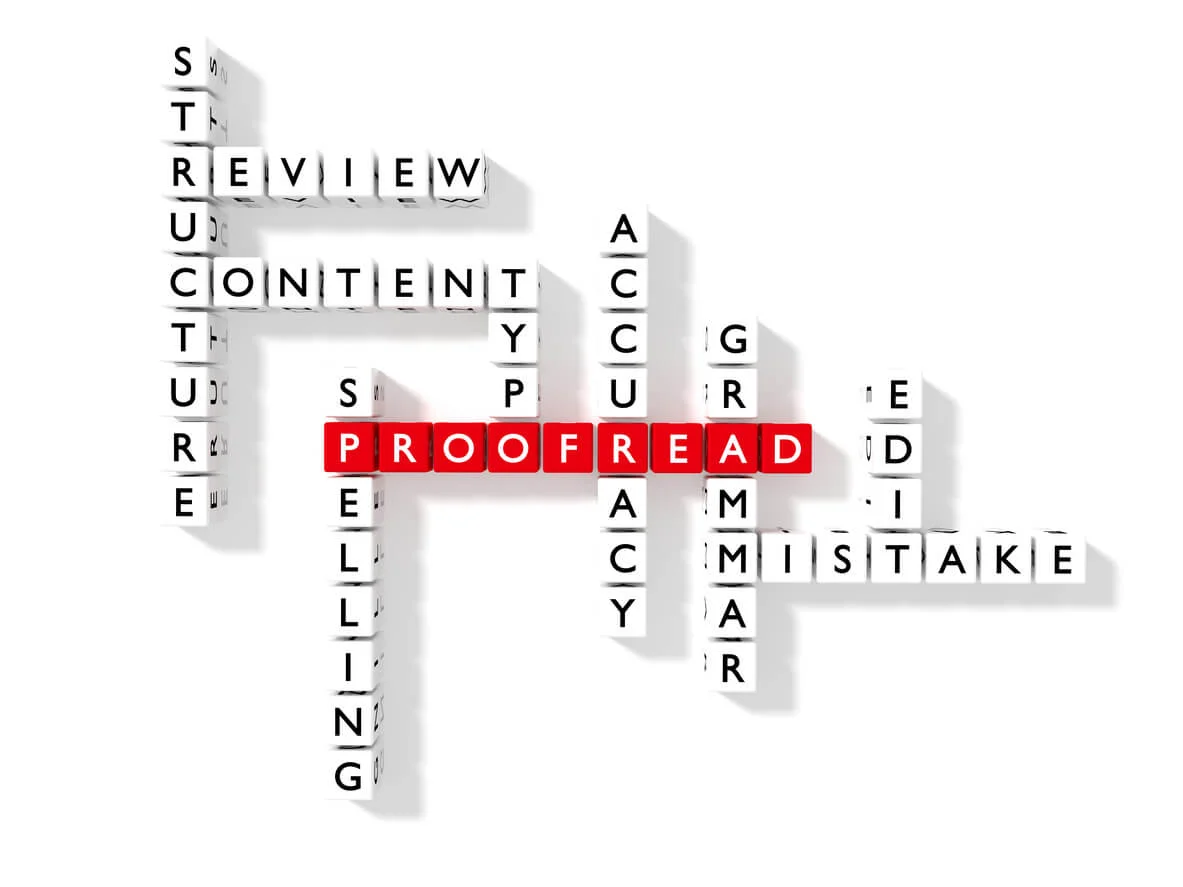Good writing is not enough. Excellent content has to encompass not just the quality of writing but also the strength of the idea. There’s a correlation between successful blogs and strong writing skills. Excellent prose and proper grammar make for good content writing skills.
A few pieces of content account for the bulk of the traffic. For a company to grow, it has to win the hearts and minds of the target audience. Successful content strategies stand the test of time, and it is free of errors. Accuracy, clarity, conciseness and coherence are the vital parameters of quality content.
In any business, communication takes the lead. Written communication leaves a sound impression. It magnifies the identity of the organization. Anybody reading the message has to understand the flow. Proofreading helps to achieve this. A final step in the editing process, proofreading is used to correct misspellings, punctuation errors and formatting issues.
To make your blog popular or to sell your product, you need to impress with your words. All the hours of researching and brainstorming go in vain if your final work is not error-free. To write a flawless, error-free piece, you need to get well versed with grammar and punctuation rules. The process of proofreading finds and fixes most of the mistakes.
Content often gets written and compiled in a pressurized environment. Multiple editors, workloads, and deadlines mean that it is possible can slip through the process. Planning, creating and executing a content strategy ensure that the message reaches the target audience.
What is Proofreading in Content Writing?
1- Proofreading vs Editing – What’s the Difference?
The terms “proofreading” and “editing” are frequently used simultaneously. But you have to understand that they’re not the same because knowing the difference is key to creating strong content.
Editing happens first, and it’s about improving the big picture. When you edit, you focus on structure, flow, and style. You might rework paragraphs to make ideas clearer. You might also cut repetitive sentences or add transitions to help readers follow along.
Proofreading comes last, and it’s the final check for errors. At this stage, you fix grammar mistakes, spelling slips, and punctuation issues. You also look for consistency—like making sure headings use the same font or dates follow the same format. Proofreading helps you to polish the details.
Think of editing as building a house and proofreading as painting the walls. One creates the structure, while the other makes it shine. You have to understand that skipping either step leaves your content unfinished.
2- Why Do People Skip Proofreading?
Even experienced writers sometimes rush through proofreading—or skip it entirely. Let’s break down why this happens.
a- Deadlines Push Quality Aside
Tight timelines are the biggest culprit in skipping proofreading. When you’re racing to finish a blog post, report, or email campaign, proofreading feels like a luxury. “It’s good enough,” you convince yourself. However, “good enough” frequently implies mistakes are made. A typo in a client proposal or a misplaced comma in a social media post can leave a bad impression.
b- Spell-Checkers Create False Confidence
Tools like Grammarly or Microsoft Word’s spell-check are helpful. But they’re not perfect. They miss homophones like “their” vs “there.” Also, they overlook punctuation errors in long sentences and can’t tell if your tone matches your audience. As a result, relying only on software can cost you more.
c- The “I’ll Fix It Later” Trap
After writing, your brain is tired because you’ve spent hours crafting sentences. You might skim through the text, thinking you’ll catch errors later. But “later” rarely happens. Once the content is published, fixing mistakes becomes reactive, and sometimes it’s too late to fix anything.
3- Why This Matters
Ignoring proofreading can risk your credibility. Imagine reading a website with spelling errors. Would you trust that business? It is found that many users say typos make them doubt a company’s professionalism. For content creators, bloggers, and marketers, that doubt can cost followers, clients, or sales.
How Proofreading Enhances Content Quality?
Proofreading makes your writing clear and easy to read. Every error that you remove adds to the quality of your message. Understand that proofreading is important for all writers because it makes sure that your ideas are shared without confusion. A careful review of your text makes a big difference.
Here’s how it improves overall content quality:
1- Improves Clarity and Readability
The first thing you should know is that good writing must be clear. Proofreading helps you to fixe awkward phrases and confusing sentences in your blogs. When you check your work, you remove extra words and unclear language. This process makes your text easier to follow. Readers appreciate clear ideas and logical flow because short sentences usually keep the writing light and direct.
2- Boosts Credibility and Professionalism
Mistakes in writing can harm your reputation. Readers may doubt your expertise when they see errors. Proofreading shows that you care about quality. When your text is error-free, it builds trust with your audience. A document free from mistakes feels polished and respectful. Also, every careful edit helps you to boost your credibility. This step shows that you value your reader’s time and understanding.
3- Keep Readers Hooked
Mistakes distract people. A misplaced comma or a wrong word forces readers to pause and decode your sentence. Every time this happens, they lose focus. Hence, clean writing keeps them moving smoothly from one point to the next.
You have to understand that structure matters, too. Proofreading ensures headings match the content below them, bullet points stay parallel, and the paragraphs aren’t too long. This makes your work visually appealing and easy to scan. On social media or blogs, where attention spans are short, this can mean the difference between a share and a scroll-past.
4- Better SEO, More Visibility
Search engines like Google prioritize high-quality content, and part of that quality is error-free writing. Google’s E-E-A-T guidelines (Experience, Expertise, Authoritativeness, Trustworthiness) highlight professionalism and clarity. Articles with grammatical errors or sentences with ambiguity tend to rank lower.
For instance, well-formatted content with good grammar and understandable headings has a greater chance of showing up on page one of search engine results. Poor content, no matter how stuffed it is with keywords, stands the chance of being buried. Proofreading makes your content meet human, as well as algorithmic, standards.
5- Quality Content – The Bigger Picture
Proofreading isn’t just about fixing errors. It’s about making your content work harder. Clear writing builds trust, and strong SEO boosts your reach. Together, these benefits make your message more effective, whether you’re writing a tweet, a report, or a blog.

What are the issues with not proofreading content?
If you are not proofreading your content, then you are making these mistakes:
- Showcases Poor Checking
- Using Copyrighted Material
- Poor Search Engine Optimization
- Little Research
- Erodes Trust
- Pointless length
- Not avoiding distractions
- Inconsistency
What are the Common Proofreading Mistakes to Avoid?
1- Homophones
Words like “their,” “there,” and “they’re” sound the same but have different meanings. These are homophones, and they’re simple to get confused. Spell-check software can miss them because they’re spelt correctly technically—just applied incorrectly.
For instance, using “The team celebrated there victory” instead of “their victory” alters the meaning. Do these kinds of errors confuse people and make your work appear sloppy? Thus, ensure that you double-check homophones manually for sure. Ask yourself: Does the word suit the context? If unsure, read the sentence aloud.
2- Punctuation Pitfalls that Affect Quality Content
Punctuation errors are small but powerful. Misplaced apostrophes can be tricky. Writing “The companies’ policy” instead of “company’s policy” suggests multiple companies, not ownership. Other than this, commas also cause trouble. Too many create choppy sentences, while too few make ideas blur together.
You have to practice using punctuation to guide readers, not confuse them. When in doubt, make sure you simplify it. Keep in mind that short sentences with clear punctuation are better than long, tangled ones.
3- Formatting Inconsistencies
Imagine reading a blog where headings switch between bold and italics randomly. Or a report where bullet points use circles in one section and dashes in another. These inconsistencies distract readers and make your work seem unpolished. Pay attention to formatting rules:
- Use the same font and heading styles throughout.
- Stick to one bullet point style (dots, numbers, dashes).
- Keep dates, times, and abbreviations consistent (e.g., “Feb.” vs. “February”).
4- Skipping the Read-Aloud Test
Silent reading allows your mind to fill in the blanks. You may skip over missing words or awkward sentences. Reading out loud compels you to slow down and listen to the way the words sound.
As an example, a sentence such as “She the report finalized yesterday” may appear on paper but not when read out loud. Poorly phrased writing, redundant words, or awkward transitions stand out. If it doesn’t sound right to read aloud, try text-to-speech software. They will point out problems that may be missed by the eyes.
5- Why These Mistakes Matter
Small errors add up, and a typo in a blog post can make readers question your expertise. Proofreading isn’t just about fixing mistakes—it’s about respecting your audience’s time and attention. The good news? These mistakes are avoidable.
You can use tools but don’t rely on them completely, or you can print your work or change the font size to see it with fresh eyes. You can also ask your colleague to review it for you.
What are the Perks of Proofreading for Quality Content?
1- Convey the information correctly-
Your work through your words creates a positive impression. Error-Free writing is the groundwork for your communication. Misplaced punctuation or a change in tense can completely change the meaning of the sentence. Along with affecting the clarity of your writing, it can turn against your benefit.
2- Imparts strength to the writing–
From essays to resumes and novels, persuasive writing free from grammatical errors makes an impact. Grammatical errors, typos and inadequate punctuation marks take away strength from your writing and reduce the influence.
3- Differentiates between extraordinary and mediocre work-
Error-Free writing will distinguish between mediocre and extraordinary work. Concise and finely written words will draw attention to your work and gain appreciation. The choice of the right words helps you look good. When you proofread, the chances are strong that you make your work more interesting.
4- Help you gain confidence-
Whether you are an amateur or a professional writer, writing error-free pieces can benefit you in many ways. When your writing is full of errors, the focus will shift to the errors, rather than your work. An error-free work will make you confident and gather praises for you.
5- Increases readability of your writing-
An error-free content offers easy readability to the viewers. Increased readability means more people would like to read your work. It can prove very beneficial to you. This way, you minimize the potential of misunderstandings by choosing the right words.
6- Minimize Translation errors-
Proofreaders go through translated content. They use their expertise in the subject and the language. Proofreading ensures that the translated content matches the source document.
7- Reduce Confusion-
A content asset should have a structure that organizes information. Mistakes can undermine our potential and credibility. A language that clearly and efficiently communicates facts and ideas is sure to receive positive attention.
8- Reputation-
For the modern digital environment, content is the key. It increases or decreases your business reputation. Proofreading adds power to the writing. By creating relevant content, you are giving potential clients’ reasons to keep coming back.
What are the Best Practices for Effective Proofreading?
Proofreading isn’t just about fixing errors. It’s about respecting your audience. Clean content shows you care about clarity and professionalism. A typo-free blog post keeps readers engaged. These practices take time, but they do pay off. You can start with one habit—like taking a break before proofreading—and build from there.
1- Step Away Before You Start
Proofreading right after writing is like trying to spot dust on a window you just cleaned. This is because your brain is too familiar with the text you’ve written the text just a while ago.
Taking a 15-minute break can also help you. When you return, you’ll see mistakes you missed earlier. This works because your mind resets and fresh eyes can catch misplaced commas, awkward phrases, and typos easily. You have to understand that distance helps you spot inconsistencies in tone or formatting. A rushed proofread wastes effort towards for quality content writing. Give yourself time to review calmly.
2- Change How You See the Text
Reading on a screen can make errors easy to overlook. So you can try printing your work. Because the paper reveals mistakes that pixels hide. If printing isn’t an option, You can also change the font or background color. Altering the visual layout tricks your brain into focusing better.
Another trick you can follow is to read your work out loud. Hearing the words helps you catch clunky sentences or missing words. If you stumble while reading, rewrite that part. This method also highlights tone issues. Does your email sound friendly or robotic? Listening clarifies this.
3- Read Backwards to Spot Typos
This might sound odd to you, but it does work. You can start with the last sentence and move upward because reading backwards breaks the natural flow, forcing you to focus on individual words. You’ll notice spelling errors like “form” instead of “from” or missing letters like “teh” for “the.”
Make sure you understand that this method isn’t for checking flow or logic; it’s a typo-hunting tool. Use it alongside regular proofreading or combine it with reading aloud for a thorough review.
4- Follow a Proofreading Checklist
A checklist for quality content keeps you organized. Create one that covers the following:
- Spelling and grammar (e.g., “their” vs “there”).
- Punctuation (commas, apostrophes, quotation marks).
- Formatting (headings, bullet points, font styles).
Update your checklist over time and add mistakes you frequently make. For example, if you mix up “affect” and “effect,” note that. Checklists turn proofreading from chaotic to systematic.
This is a good starting point for a robust proofreading checklist.
What Tools and Resources Help in Better Proofreading?
You can pick between paid and free options for proofreading. Free tools work well for everyday writing, like emails or blog drafts. Paid services suit formal documents or projects where errors could harm your reputation. Whether you pick free or paid, consistency matters. Pairing tools with human review can provide you with the best results.
| Category | Tool/Service | Best For |
| Grammarly | Fixing grammar, spelling, and basic tone issues. | |
| Free Tools | Hemingway Editor | Simplifying complex sentences and improving readability. |
| ProWritingAid | Detailed style checks and reducing repetition. | |
| Paid Services | Professional Editors | Personalized feedback for resumes, reports, or books. |
| Scribendi | Fast, reliable proofreading for urgent or important projects. |
To conclude
Proofreading plays a vital role in the overall quality of any written work. It improves clarity and makes ideas easier to understand. It also boosts credibility and encourages reader engagement. When errors are removed, the message becomes clear and reliable. Make sure you know that the common mistakes can confuse readers and weaken your argument. By following best practices, you improve the logical flow of your writing.
Drafting quality content that is free of mistakes, spell checks, and grammatical errors ensure the highest standards. Professional proofreaders, with their extensive experience, can handle business communication with ease. The process of proofreading is instrumental in getting your idea across in an accessible and logical manner.
Connect with Textuar for content that is polished and engaging at the same time.
Proofreading for Quality Content FAQs
Q1 – How is editing different from proofreading?
Editing enhances the flow, structure, and style of your content. It involves rewriting sentences or restructuring paragraphs. On the other hand, proofreading is the last step since it concentrates on correcting grammar, spelling, and format mistakes. Imagine editing as refining the message and proofreading as buffing it, and neglecting either of them can make readers confused or compromise your credibility.
Q2 – How many times should I proofread my work?
Aim for at least two rounds for quality content. First, check grammar and spelling. Second, review formatting and consistency. For critical documents, you can also add a third round. Be sure to take breaks between sessions in order to catch errors you overlooked the first time around. Aids such as Grammarly assist, but don’t fully trust them because human eyes detect errors that computer programs usually overlook.
Q3 – What are the most frequent proofreading errors?
The most common mistake is combining homophones (such as “your” and “you’re”). In lengthy sentences, it’s also very usual to miss punctuation, such as commas. A disorganized appearance is produced by inconsistent formatting, such as alternate fonts or spacing. Finally, skipping the “read-aloud” test often leads to awkward phrasing. These small errors add up and distract readers from your message.
Q4 – Can proofreading improve my content’s performance?
Yes. Error-free, clean content holds readers for longer periods. Search engines prefer well-organized writing, which can increase SEO rankings. To marketers, error-free posts generate trust and induce social shares. Bloggers and professionals earn credibility with error-free blogs or articles. Remember that proofreading converts good content to credible, shareable work.










